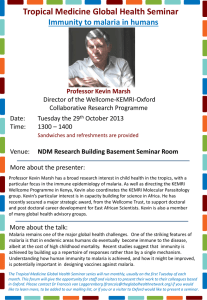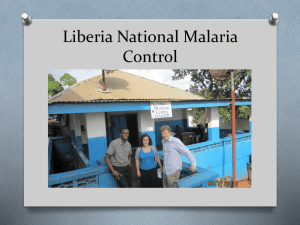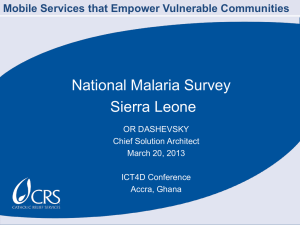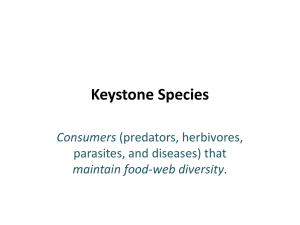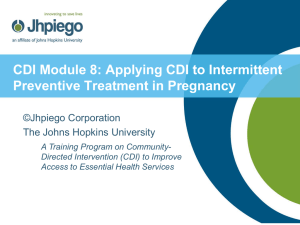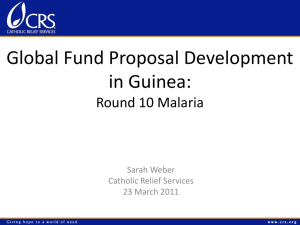- National Press Foundation
advertisement
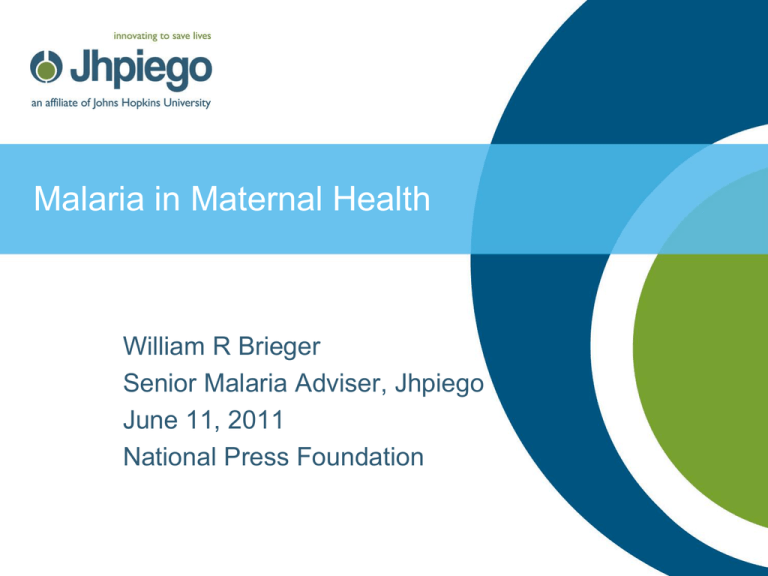
Malaria in Maternal Health William R Brieger Senior Malaria Adviser, Jhpiego June 11, 2011 National Press Foundation Malaria Risk Measured by Parasites (top) and Aridity/Humidity (bottom) 2 Maternal Mortality – Deaths per 1000 Live Births http://www.who.int/making_pregnancy_safer/en/ 3 Does this occur by chance? Malaria Maternal Mortality 4 Malaria is an Important Contributor to Maternal Mortality in Endemic Countries Anemia 11% Other 5% Haemorrhage 23% Malaria 11% Infection 17% Obstructed labour 11% Unsafe Abortion 11% Toxemia/ Eclampsia 11% 5 Malaria during pregnancy: bad news Each year, more than 30 million women in Africa become pregnant in malaria-endemic areas. Malaria during pregnancy in sub-Saharan Africa is estimated to account for: 400,000 cases of severe anemia in pregnant women ~ 35% of preventable low birth weight ~ 5% of infant mortality – 75,000 - 200,000 infant deaths annually 6 Why Is Malaria in Pregnancy (MIP) Important? MIP effects on Women 2-15% of maternal anemia Possibly up to 10,000 maternal deaths annually Possible effects on pre-eclampsia Increased post-partum hemorrhage Source: WHO Afro 2004 7 Placental Malaria in African Women: the First Pregnancy Is Most Dangerous Multigravida i al aw M Za ire er ia N ig aU G am bi aR am bi G C oa a Iv or y an i Ta nz U ga nd st 70 60 50 40 30 20 10 0 a Prevalence % Primigravida Placental malaria deprives the fetus of nutrients 8 MIP effects on fetus/child 13-70% intrauterine growth retardation As high as 20% of low birth weight newborns 30% of “preventable” low birth weight newborns 8-36% of preterm births ~5% congenital malaria in newborns 3-5% of newborn deaths, 3-8% of infant deaths Miscarriage and stillbirth 9 Low Birth Weight Predisposes to Other Causes of Neonatal and Infant Death Frequency of Low Birth Weight by Placental Malaria Infection % Low Birth Weight 35 30 With placental parasites 25 20 Without placental parasites 15 10 5 0 First Pregnancy Second Pregnancy Source: Steketee 2001: Malawi 1988-1991 Three or more pregnancies 10 Characteristics of Malaria Transmission Stable Areas Year-round transmission e.g. Nigeria Unstable Areas Seasonal or epidemic transmission e.g. South Africa People receive frequent People are infrequently infective mosquito bites each month Levels of acquired immunity are high (pregnant women are semi-immune to malaria) Low peripheral parasitemia Heavy placental infection exposed to malaria Levels of acquired immunity are low (pregnant women are not immune) Heavy peripheral parasitemia Low or undetectable placental infection 11 Effect of MIP in Stable Transmission Areas Acquired immunity – high 1st & 2nd pregnancies at Plasmodium falciparum malaria Asymptomatic Infection greatest risk Prevention essential (as most Placental Sequestration Altered Placental Integrity women are not symptomatic) Reduced Nutrient and Oxygen Transport Anemia Low Birth Weight (IUGR) Risk of Newborn Mortality Source: WHO 2002. 12 Effect of MIP Unstable Transmission Areas Acquired immunity – low All pregnancies affected Acquired Immunity – Low equally Prompt diagnosis and Clinical Illness treatment needed in addition to prevention Severe Disease Risk to Mother Source: WHO, 2002 Risk to Fetus 13 INTERVENTIONS TO CONTROL MALARIA IN PREGNANCY WHO’s 3-pronged approach 14 Three Main Control Tools IPTp = Intermittent preventive treatment in pregnancy ITNs = Use of insecticide-treated nets, including long lasting insecticide treated nets (LLINS) Case management of malaria disease Diagnosis with Rapid Tests, Microscopy Appropriate antimalarial drug for treatment Indoor Residual Spraying not specific to MIP, but where offered should be mentioned in health education to women 15 16 Intermittent Preventive Treatment in Pregnancy IPTp is an approach for effectively preventing and controlling malaria during pregnancy that Is based on an assumption that every pregnant woman in a malaria-endemic area is infected with malaria, and Recommends that every pregnant women receive at least two treatment doses of an effective antimalarial drug as a preventive measure Sulfadoxine-pyrimethamine (SP) currently considered the most effective drug for IPTp 17 IPTp with Sulfadoxine-Pyrimethamine SP is a combination of two different drugs. Each tablet of SP contains: 500 mg of sulfadoxine, and 25 mg of pyrimethamine A single dose consists of three tablets taken at once, preferably under direct observation of the healthcare provider Fansidar is the most common brand name. Others include Falcidin, Laridox, Maladox, Orodar, Maloxine SP is generally more effective than chloroquine which is no longer effective in most countries because of parasite resistance 18 Effect of IPTp with SP Case management alone does not reduce effects of malaria in pregnancy as well as IPTp Not all women with malaria parasites have symptoms, and therefore would not receive treatment if we relied solely on case management IPTp produced better outcomes in terms of reducing Maternal and placental parasitemia Low birth weight IPTp is as effective as case management in terms of improving hemoglobin levels 19 Fetal Growth Velocity Fetal growth velocity Last month 10 Conception Source: WHO 2002. 16 20 Weeks of gestation 30 Birth 20 Fetal Growth Velocity: Quickening Fetal growth velocity Last month Quickening 10 Conception Source: WHO 2002. 16 20 Weeks of gestation 30 Birth 21 Rationale for the Timing of the SP Doses Fetal growth velocity Rx Rx Last month Quickening 10 Conception Source: WHO 2002. 16 20 Weeks of gestation 30 Birth 22 Key Issues About Timing of Doses SP should be avoided during the first 16 weeks of pregnancy which is the period of initial development of the fetus It is best to clear the placenta of parasites during the period of maximum fetal growth IPTp allows the mother to recover from anemia by clearing peripheral parasitemia A note for the future – SP resistance is growing, and at some point a new medicine for IPTp will be found More on this later 23 Steps for Providing IPTp with SP Determine quickening has occurred Inquire about history of severe skin rash from previous SP use Inquire about use of SP in last month Provide three tablets of SP with clean water in a clean cup Observe the patient swallowing all three tablets (Directly Observed Treatment or DOT strategy) DOT is one reason to ensure that IPTp is an essential component of an integrated ANC program Do not encourage women to undertake IPTp on their own 24 Steps for Providing IPTp with SP (continued) Record SP on the antenatal card and the clinic record Instruct clients to return at next scheduled visit or earlier if she is feeling ill Drop-out is a major challenge for successful IPTp programs From 20-50% of women do not receive a second dose Inform clients that IPTp is most effective if they receive at least two doses Ask about side effects from previous dose before giving the next dose, which should not be less than 4 weeks from the last dose 25 SP Resistance and IPTp Waning efficacy of SP in treating symptomatic children <5 years does not equate with waning efficacy for prevention of malaria during pregnancy IPTp with SP remains efficacious even in settings with significant (<50%) treatment failure in symptomatic children 6-59 months of age More than 2 doses are likely beneficial given rising resistance 26 SP IPTp – Monthly Dosing SP SP Fetal growth velocity SP SP resistance shortens duration post-treatment prophylaxis 10 Conception 20 30 Weeks of gestation Source: CDC Scott Filler October 2007 Birth 27 Malawi Randomized Controlled Trial of IPTp: Does monthly IPTp provide additional benefit over 2dose IPTp? In preventing placental malaria For HIV-positive/negative women Is SP efficacious for IPTp despite 31% SP failure rate for treatment in young children?* For HIV-positive pregnant women, monthly SP IPTp more efficacious than 2-dose SP IPTp in reducing placental malaria For HIV-negative pregnant women, monthly SP IPTp may have benefit over 2-dose SP IPTp Despite treatment failures in children, SP remains efficacious for IPTp *Malawi Ministry of Health and Population Report, 2004 28 APPROPRIATE CASE MANAGEMENT Parasitological diagnosis Treatment with appropriate medicines Counseling to ensure adherence 29 Case Management: Drug Efficacy Malaria episodes in pregnancy are serious and must be treated promptly with an appropriate drug Effective drugs are needed for P. falciparum malaria as it can be fatal to both mother and child Remember differences between stable and unstable transmission areas Note importance of diagnosis 30 Importance of diagnosis Laboratory/slide diagnosis is still the gold standard Few front line clinics have labs and/or trained staff Rapid diagnostic tests are becoming more available Can reduce treatment costs only treat ‘real’ malaria cases Storage issues in terms of temperature, expirey dates 31 RDTs make diagnosis possible and save lives http://www.fightingmalaria.info/vr3 32 Drug Choice Drug of choice depends on the geographic drug resistance profile and national malaria drug policies Quinine is the drug of choice for malaria in first trimester pg pregnancy SP is reserved for IPTp Artemisinin-based combination therapy (ACT) drugs can be used after the first trimester 33 All Kinds of Malaria Drugs Are on the Market … but not all are safe or appropriate 34 Resistance to Drugs Resistance of P. falciparum to antimalarial drugs is an ever increasing problem To minimize the problem of drug resistance, encourage women to complete their course of antimalarial drugs, even when they feel better Drug resistance is inevitable; therefore healthcare providers must stay informed about policy changes recommended by their Ministry of Health 35 Drugs Not To Be Used During Pregnancy Tetracycline Cause abnormalities of skeletal and muscular growth, tooth development, lens/cornea Doxycycline Risk of cosmetic staining of primary teeth is undetermined Excreted into breast milk Primaquine Harmful to newborns who are relatively Glucose-6- Phosphatase-Dehydrogenase (G6PD) deficient Halofantrine No conclusive studies in pregnant women Has been shown to cause unwanted effects, including death of the fetus, in animals 36 INSECTICIDE TREATED NETS Start net use as early in pregnancy as possible Insecticide-Treated Nets (ITNs) An ITN is a mosquito preventing bednet (or other netting material such as curtains) that has been soaked in a safe insecticide The insecticide kills the mosquito when it comes near the sleeping person Traditional ITNs required re-treatment with insecticide every six months While ITNs are still available in many countries, most are switching to long lasting insecticide-treated nets (LLINs) where the insecticide is applied at the factory LLINs can withstand washing up to 20 times and may last over 4 years 38 Use ITNs/LLINs The use of ITNs/LLINs have been shown to result in reduction of newborns born with low birth weight or prematurely ITNs reduce transmission by physically preventing vector mosquitoes from landing on sleeping persons 39 ITN/LLIN Benefits Repel and kill mosquitoes that come in contact with the net Kill other insects like cockroaches, lice, ticks and bed bugs Should be used by pregnant women as early during pregnancy as 40 Impact on Fetal Growth and Duration of Gestation Pregnant women protected by insecticidetreated nets were less likely To deliver prematurely or To have small-for-gestational-age newborns Compared to control groups who were not protected by the nets This finding holds true irrespective of the woman’s parity, except for the incidence of small-for-gestational-age babies born to women with 4 or more pregnancies Source: ter Kuile et al 1999 41 ITN: Impact on Fetal Growth and Duration of Gestation % 45 Premature LBW Premature or LBW Percentage 40 35 30 control 25 bednets 20 15 10 5 0 Gravidity Source: ter Kuile et al 1999; LBW = Low Birth Weight 42 Impact of ITNs on Maternal and Newborn Health Among Gravidae 1-4, ITNs were associated during pregnancy with: 38% reduction in peripheral parasitemia 21% reduction in all causes of anemia (Hb < 11 g/dl) 47% reduction in severe malarial anemia Source: Shulman 2001: Western Kenya 43 Impact of ITNs at Delivery At delivery 23% reduction in placental malaria 28% reduction in LBW 25% reduction in any adverse birth outcome No trend towards decreasing efficacy with increasing transmission rate 44 ITN/LLIN Procurement and Management It is quite popular these days to provide ITNs within childhood immunization campaigns It is less common to find that ITNs have been allocated in adequate numbers to be given out as an essential component of focused ANC The district health management team needs to meet and plan for adequate nets, not only for children under five years of age, but also ensure that adequate nets are supplied to ANC clinics ITN/LLIN provision can be an important incentive to attend ANC A woman should get a net on her first ANC visit when it can offer the most protection during pregnancy 45 CHALLENGES Correct use and adequate coverage 46 Examples of MIP Data/Indicators (from surveys 2006-08) 80 70 70 Percentage 60 50 80% was RBM target for 2010 60 51 50 47 43 40 35 32 32 26 30 17 20 10 17 20 14 7 3 12 5 0 Zambia IPTp2 Senegal Angola Tanzania Slept under Any Net Malawi Nigeria Slept under ITN 47 Most women attend ANC in Africa, but they may not make two visits that support IPT compliance 100 90 80 % women 70 60 50 40 30 20 Any ANC visit Ave 20 ETH MAL MAU ERI CAM MOZ BEN GHA TAN ZAM 0 GAB 10 IPT compatible *E Eckert, A Hyslop, R Snow, MEASURE Evaluation, Macro International, APHA 2005 48 Senegal – who slept under a net? 80 RBM 2010 Target is 80% 70 Percent 60 50 41.5 40 30 27.9 24.1 39.1 44.2 26.8 20 10 0 All Households Child <5 All Women 15-49 2008-09 Senegal Malaria Indicator Survey HH with LLINs Pregnant Women 49 Can We Prevent Net Misuse? 50 AN INTEGRATED APPROACH TO MIP CONTROL Improved Health Systems Focused Antenatal Care Attention to HIV/AIDS Community Involvement 51 Malaria in Pregnancy Systems Readiness Component Indicators Policy Policy, strategy and service delivery guidelines developed and being used at all levels of the health system Commodities Drug procurement and distribution systems efficient; WHO-recommended medicines for malaria and/ or MIP are always available; ITNs always available Quality Assurance MIP quality assurance standards have been developed and are used in systematically; supportive supervision for MIP services utilized systematically 52 Malaria in Pregnancy Systems Readiness Component Indicators Training In-service training on MIP conducted for all appropriate cadres of health service providers; updated pre-service nursing, midwifery and medical MIP curricula is being taught at all academic institutions Integration Joint strategies, planning and sharing of information between National Malaria Control Programs at national level; district level promotes integration of RH, HIV/AIDS and MIP in administration and supportive supervision; MIP, reproductive health and/or HIV/AIDS are provided together in health services 53 Malaria in Pregnancy Systems Readiness Component Indicators Communitybased MIP Programs Community action groups are strong partners in national MIP prevention efforts; appropriate resources widely available M&E HMIS systems strong; MIP indicators being collected regularly; some endline studies designed to capture achievements and / or impact studies being conducted Financing National government has committed and disbursed funds to MIP programs which significantly contribute to projected costs; ample donor funding exists 54 Antenatal Care as a Platform for MIP Control Antenatal visits provide a unique opportunity for: Monitoring of maternal and fetal health during pregnancy immunizations Provision of micronutrients (e.g., iron folate) Health education about malaria during pregnancy IPTp with sulfadoxine-pyrimethamine (SP) ITN distribution Prompt diagnosis and treatment of malaria Prevent mother-to-child transmission of HIV District health teams must promote timely ANC attendance if MIP interventions are to reach the maximum number of pregnant women 55 Focused Antenatal Care (FANC) Early detection and treatment of problems and complications Prevention of complications and disease Birth preparedness and complication readiness Health promotion First visit: Within 16 weeks or when woman first thinks she is pregnant Second visit: At 20-24 weeks or at least once in second trimester Third visit: At 28-32 weeks Fourth visit: At 36 weeks or later 56 Summary of Malaria Activities at FANC 1st Visit 2nd Visit 3rd Visit 4th Visit IPTp Yes (if after 16 weeks) Yes (if one month after 1st) Yes (if one month after 2st) Additional if not all IPTp received ITN Provide Counsel on use Counsel on use Counsel on use Treatment As needed after test As needed after test As needed As needed after test after test 57 Bad Combination: Placental Parasitemia and HIV % parasitemic Placental Parasitemia by HIV Status and Pregnancy Number, Kenya, 1996-1998 40 35 30 25 20 15 10 5 0 Parasite density/mm3 1-999 231 G1 159 G2 HIV (+) 197 G3 1000-9,999 772 >10,000 402 479 G1 G2 HIV (-) G3 Summary RR = 1.63 (1.41-1.89), p <0.001 Total n = 2263 Source: van Eijk AM et al 2001. 58 Nigeria MIP Community-Clinic Partnership for Community Directed Intervention CLINIC MIP performance standards developed and implemented 59 Training, Supervision, Mobilization, Commodities Referrals, Records, Feedback COMMUNITY MIP skills and responsibilities implemented through communitydirected intervention Community Directed Intervention Program Impact: Improved IPTp Uptake 80 71 70 65 60 52 50 40 27 30 20 10 12 6 11 5 0 Intervention Baseline IPTp1 Endline IPTp1 Control Baseline IPTp2 Endline IPTp2 60 ITN Use by Pregnant Women through Community Directed Intervention 45 40 40 35 30 30 28 25 20 20 15 10 5 0 Intervention Control Baseline ITN Endline ITN 61 The Good News: Save the Children Documents Progress in Maternal Survival 62 Summary Malaria during pregnancy has adverse consequences for mothers and their babies Malaria preventive package includes: Intermittent preventive treatment during pregnancy with SP during antenatal clinic visits Use of ITNs/LLINs throughout pregnancy and in the postpartum period Prevention must be complemented by effective case management of malaria illness for all women of reproductive age Health Systems issues must be addressed from national to facility level to ensure full delivery of MIP services 63 Contact Information William Brieger http://www.malariafreefuture.org/blog/ Senior Malaria Specialist, JHPIEGO http://www.jhpiego.org/whatwedo/malaria.htm Professor, Health Systems Program, Department of International Health, The Johns Hopkins Bloomberg School of Public Health http://faculty.jhsph.edu/Default.cfm?faculty_id=90; bbrieger@jhsph.edu; bbbrieger@yahoo.com malaria updates at: http://twitter.com/bbbrieger 64


